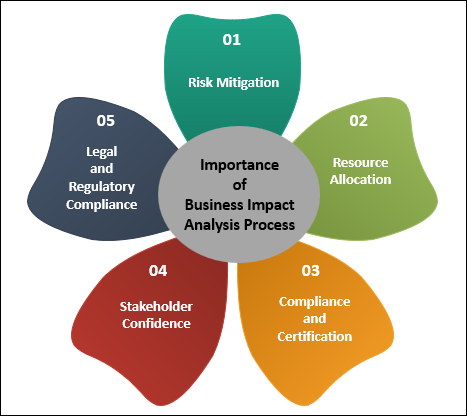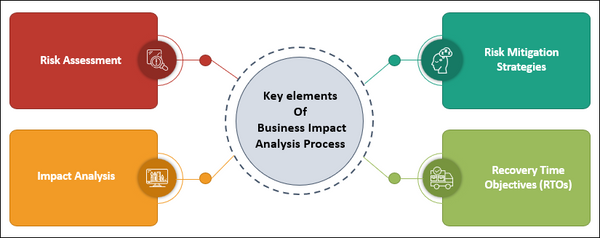ISO 22301:Business Impact Analysis Process
ISO 22301, the International Organization for Standardization's (ISO) standard for business continuity management, is a critical framework for ensuring an organization's resilience in the face of disruptions. Central to ISO 22301 is the Business Impact Analysis (BIA) process, a systematic and thorough examination of an organization's operations.
The BIA process is a cornerstone in identifying and prioritizing critical business functions, understanding the impact of disruptions, and determining recovery strategies. It plays a pivotal role in developing a robust business continuity plan, ensuring that organizations can continue operating even in the face of unforeseen challenges. In this introduction, we will delve deeper into the significance and key elements of the ISO 22301 BIA process, highlighting its importance in safeguarding business continuity and minimizing downtime.
Importance of ISO 22301:Business Impact Analysis Process
- Risk Mitigation: The BIA process helps organizations identify potential risks and vulnerabilities in their operations. By understanding how various disruptions can impact critical business functions, they can proactively develop strategies to mitigate these risks.
- Prioritization of Business Functions: BIA enables organizations to prioritize their business functions based on their criticality. This ensures that resources are allocated to the most essential activities, enhancing the ability to recover from disruptions effectively.
- Resource Allocation: By knowing the impact of disruptions on various functions, organizations can allocate resources efficiently. This prevents the wastage of resources on less critical aspects and ensures the availability of necessary resources for key functions during recovery.
- Compliance and Certification: Many industries and clients require ISO 22301 compliance as a prerequisite for business relationships. Achieving certification demonstrates a commitment to business continuity, which can be a competitive advantage.
- Reduction in Downtime: With a well-executed BIA, organizations can significantly reduce downtime in the event of a disruption. This is critical for maintaining customer trust, avoiding financial losses, and preserving reputation.
- Improved Decision Making: BIA provides data-backed insights into the impact of disruptions, aiding in informed decision-making. This allows organizations to make strategic choices on risk management and recovery plans.
- Enhanced Resilience: The BIA process fosters a culture of resilience within an organization. Employees become more aware of the importance of their roles in business continuity, making the entire organization more resilient.
- Cost Savings: Through BIA, organizations can identify cost-effective strategies for maintaining critical functions during disruptions. This can lead to cost savings in the long run by reducing the financial impact of crises.
- Stakeholder Confidence: Having a robust BIA and business continuity plan instills confidence in stakeholders, including customers, investors, and partners. They know that the organization is well-prepared to handle disruptions.
- Legal and Regulatory Compliance: In many industries, there are legal and regulatory requirements for business continuity planning. Compliance with ISO 22301 through a well-executed BIA ensures that an organization meets these obligations.
Key elements of ISO 22301:Business Impact Analysis Process
- Identification of Critical Functions: The first step is to identify and document all business functions within the organization. From there, critical functions that are essential for maintaining operations are determined. These are often called "critical assets."
- Risk Assessment: Each critical function is subjected to a comprehensive risk assessment. This involves identifying potential threats, vulnerabilities, and the impact of various disruptive events on these functions. It helps in understanding the likelihood and consequences of disruptions.
- Impact Analysis: For each critical function, an impact analysis is conducted. This process quantifies the potential financial, operational, and reputational impact of a disruption. It helps in prioritizing functions based on their criticality.
- Recovery Time Objectives (RTOs): RTOs are established for each critical function. These define the maximum tolerable downtime for a function, helping in setting recovery priorities and strategies.
- Resource Assessment: It's essential to determine the resources required for the recovery of critical functions. This includes personnel, technology, facilities, and equipment.
- Dependencies and Interdependencies: Organizations analyze the dependencies and interdependencies between functions. This helps in understanding how a disruption in one area might affect others and guides the development of recovery plans.
- Risk Mitigation Strategies: Once risks are identified, organizations develop risk mitigation strategies to reduce the likelihood and impact of disruptive events. This may include security measures, redundancy, and crisis management plans.
- Recovery Strategies: Based on the BIA findings, organizations develop recovery strategies for each critical function. These strategies outline the actions needed to restore normal operations within the defined RTOs.
- Documentation: All BIA findings, including critical function assessments, risk assessments, impact analyses, recovery strategies, and resource requirements, are thoroughly documented. This documentation is vital for the development of the business continuity plan.
- Testing and Validation: BIA results are validated through testing and exercises. This includes scenario-based drills to ensure that recovery strategies are effective and that employees understand their roles in business continuity.
- Regular Updates: BIA is not a one-time process. It needs to be updated regularly to account for changes in the organization, its environment, and emerging risks. This ensures that the business continuity plan remains relevant.
The Benefits of ISO 22301:Business Impact Analysis Process
- Enhanced Business Continuity: The BIA process is instrumental in identifying critical functions and their dependencies. By understanding these, organizations can develop more robust business continuity plans, ensuring that essential operations continue in the face of disruptions.
- Risk Reduction: Through a thorough BIA, organizations can identify vulnerabilities and risks. This allows them to proactively implement risk mitigation strategies, reducing the likelihood and impact of disruptive events.
- Resource Optimization: BIA helps in determining the precise resource requirements for recovery. This prevents over-allocation of resources to less critical functions and ensures that resources are available where they are most needed.
- Cost Efficiency: By understanding the financial impact of disruptions on critical functions, organizations can make informed decisions about resource allocation and recovery strategies, leading to cost savings in the long run.
- Compliance and Competitive Advantage: Achieving ISO 22301 compliance and certification demonstrates a commitment to business continuity. This can be a competitive advantage, especially when competing for contracts and partnerships in industries where continuity is crucial.
- Reduced Downtime: BIA aids in setting Recovery Time Objectives (RTOs) and developing effective recovery strategies. This leads to quicker recovery and reduced downtime, minimizing financial losses and customer dissatisfaction.
- Informed Decision-Making: BIA provides data-driven insights into the impact of disruptions, enabling organizations to make informed decisions regarding risk management, resource allocation, and recovery plans.
- Resilient Organizational Culture: The BIA process fosters a culture of resilience within an organization. Employees become more aware of the importance of their roles in business continuity, making the entire organization more resilient to disruptions.
- Stakeholder Confidence: A well-executed BIA and business continuity plan instill confidence in stakeholders, including customers, investors, and partners. They know that the organization is well-prepared to handle disruptions.
- Legal and Regulatory Compliance: BIA helps organizations meet legal and regulatory requirements in various industries, ensuring that they are prepared for crises and disruptions as mandated by authorities.
- Improved Recovery Strategies: By understanding the specific impact of disruptions on each critical function, organizations can tailor recovery strategies to the unique needs of those functions, making the recovery process more efficient.
- Better Incident Response: BIA contributes to a more effective incident response. When disruptions occur, organizations are better equipped to respond quickly and effectively due to their understanding of critical functions and dependencies.
- Continuous Improvement: BIA is not a one-time process. Regular updates and testing ensure that the organization's business continuity capabilities are continually improving and adapting to changing circumstances.
Conclusion
In conclusion, the ISO 22301 Business Impact Analysis (BIA) process is an indispensable tool for organizations aiming to fortify their resilience and ensure business continuity in an ever-changing and often unpredictable business landscape. Through the systematic identification of critical functions, risk assessment, and impact analysis, the BIA empowers organizations to make informed decisions, allocate resources efficiently, and develop targeted recovery strategies.
The benefits are substantial, encompassing reduced downtime, cost savings, compliance with regulatory requirements, and a competitive edge. Moreover, the BIA process instills a culture of preparedness and resilience throughout the organization, enhancing stakeholder confidence and improving incident response. As an ongoing practice, the BIA evolves with the organization, adapting to emerging risks and changing business dynamics. In a world where disruptions are an inevitability, the ISO 22301 BIA process stands as a cornerstone for ensuring that businesses can weather the storms, maintain operations, and emerge stronger from adversity.



